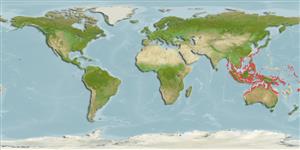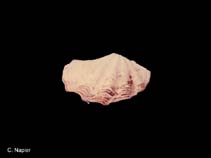Tridacna crocea Lamarck, 1819
Crocus giant clam| Native range | All suitable habitat | Point map | Year 2050 |

|
| This map was computer-generated and has not yet been reviewed. |
| Tridacna crocea AquaMaps Data sources: GBIF OBIS |
Classification / Names Common names | Synonyms | CoL | ITIS | WoRMS
Bivalvia | Cardiida | Cardiidae
Environment: milieu / climate zone / depth range / distribution range Ecology
Benthic; depth range 0 - 20 m (Ref. 348), usually 0 - 20 m (Ref. 75831). Tropical; 23°C - 30°C (Ref. 102835); 31°N - 30°S, 92°E - 178°W (Ref. 106696)
Distribution Countries | FAO areas | Ecosystems | Occurrences | Introductions
Indo-West Pacific: from Andaman Islands to Fiji Islands; north to Japan and south to New Caledonia and Queensland.
Length at first maturity / Size / Weight / Age
Maturity: Lm ? range ? - ? cm Max length : 15.0 cm SHL male/unsexed; (Ref. 348); common length : 11.0 cm SHL male/unsexed; (Ref. 348)
Short description Morphology
The valves are greyish white, often fringed with orange or yellow both inside and out. They are triangularly ovate in shape. Mantle coloration is predominantly blue but shows great variability.
Found in intertidal areas on corals (Ref. 75831).
Life cycle and mating behavior Maturity | Reproduction | Spawning | Eggs | Fecundity | Larvae
Broadcast spawners. Life cycle: Embryos develop into free-swimming trocophore larvae, succeeded by the bivalve veliger, resembling a miniature clam (Ref. 833).
Main reference
References | Coordinator | Collaborators
Poutiers, J.M. 1998. (Ref. 348)
IUCN Red List Status (Ref. 130435)
Lower Risk: least concern (LR/lc) ; Date assessed: 01 August 1996
CITES status (Ref. 108899)
Appendix II: International trade monitored
CMS (Ref. 116361)
Not Evaluated
Threat to humans
Harmless
Human uses
Fisheries: commercial
FAO - Aquaculture: production; | FishSource |
Tools
More information
Internet sources
BHL | BOLD Systems | CISTI | DiscoverLife | FAO(; publication : search) | Fishipedia | GenBank (genome, nucleotide) | GloBI | Gomexsi | Google Books | Google Scholar | Google | PubMed | Tree of Life | Wikipedia (Go, Search) | Zoological Record
Estimates based on models
Preferred temperature
(Ref. 115969): 25.1 - 29.1, mean 28.3 (based on 1078 cells).
Price category
(Ref. 80766):
Unknown.



